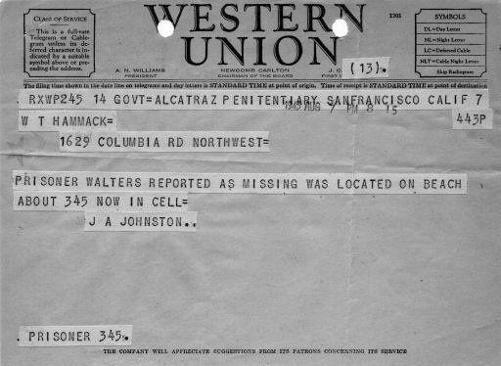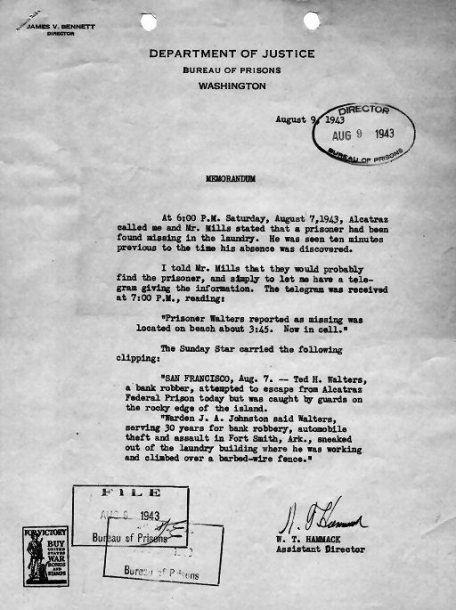Information has come to my attention that this inmate, together with Floyd Hamilton, and inmate Reed were planning and plotting an escape from the institution by concealing themselves in an institutional sawdust truck driven by Lee Barker, No. 53385-L, a confessed conspirator with Steffler and Miles in a similar plot. While definite information is meager, regarding this particular conspiracy, it was upon this same information that the plot was of Steffler and Miles were finally discovered. The plot had also included the fabrication of homemade shotguns, shells, and sixteen bombs that were to be made in the prison factories. An inmate not connected with the plot furnished the information. In talking with Hamilton relative to this plot, Hamilton admits that Reed and Walters were his only trusted associates in the institution. Further, early in December, Walters was observed at about 3:30 PM sitting outside the Shoe Factory, “casing” the East Gate and the general truck shakedown. This at a time when he was supposed to have been at his work in the Clothing Factory. This inmate has a long dangerous record, and is one of the most vicious criminals in the Southwest, and co-partner of Hamilton’s. In view of his long sentence and the actually known conspiracies of his co-partner Hamilton, it is recommended that he be transferred to Alcatraz for safer custody.
Walter and Hamilton arrived at Alcatraz on June 9, 1940. Here too, both men continued to receive negative conduct reports for numerous infringements of prison regulations. On April 14, 1943, as described in the preceding chapter, Hamilton and fellow inmates James Boarman, Harold Brest and Fred Hunter participated in a failed escape that would cost Boarman his life.
On August 7, 1943, only months after Hamilton’s luckless escape attempt, Walters decided to try his fate against the Rock. He had been assigned to the laundry for nearly two years and in the spirit of Hamilton’s escape, he had been collecting military clothing stuffed in one-gallon containers, which he would attempt to use as floats. Even though the concept had been tried unsuccessfully on three previous attempts, it still seemed to be the most promising scheme. Walters had also been able to acquire $42, which he stuffed into one of the pant pockets for use once he made it to shore.
On the day of the escape, sometime between 2:15 p.m. and 3:45 p.m., Walters quietly slipped away from sight. Because of staffing shortages, the number of officers posted in the Industries Building had been reduced. Clutching his two one-gallon containers and with no officer in direct view, Walters carefully made his way to the fence line. He had also acquired a pair of electrician’s wire cutters, which he intended to use to cut through the heavy security fencing. But no matter how hard he squeezed the small handles against the stiff galvanized wire, the cutters proved completely ineffective. Keeping a close eye on the towers, he carefully stacked some packing crates next to the perimeter fence, and then risked scaling it in view of the tower guards, who failed to spot the escapee. As he maneuvered over the skin-piercing barbed wire at the top, he lost his grip and fell. The fall proved to be treacherous and resulted in a serious back injury. In acute pain, Walters descended the steps that led to the water’s edge, and then contemplated his swim to the mainland.
Inside the laundry building, a supervisor making his rounds noticed Walters was absent from his workstation and immediately contacted the Armory. The alarm was quickly sounded, as Walters stood by the water’s edge, now stripped to his underwear and facing the reality that his plan had failed. A Coast Guard cutter was quickly dispatched and found Walters standing stripped down on the bank. Captain of the Guards Henry Weinhold and Associate Warden E.J. Miller captured Walters without any resistance, and brought him to the hospital to be examined. Walters spent nearly ten days in the hospital before being taken to D Block.


In a letter from Bureau of Prisons Director James V. Bennett to Warden Johnston dated August 12, 1943, it is clear that Bennett was unsatisfied with the performance of the officers. He also firmly made the point that Walters should have been spotted by the tower officers when he was climbing the fences. A telegram to Warden Johnston read:
Have asked Captain Conner to check on the Ted Walters escape and confer with you as to what action if any should be taken with respect to the officers since I cannot understand how Walters could have climbed the fence in plain daylight without being noticed by tower offices unless they were inattentive to their duties in which case disciplinary action should be taken. Captain Conner will arrive August Sixteenth.
After being released from the hospital, Walters was tried by a specially assembled disciplinary board. The following is a transcript from his hearing:
In accordance with the regulations of the Bureau of Prisons governing the forfeiture of GOOD TIME, a special court was appointed by the Warden for the purpose of trying Huron Ted Walters, Reg. No. 536-AZ, and for his misconduct, specifically:
Leaving place to which he was assigned in laundry, dropping from walk-way to get out of sight of road tower guard, carrying wire cutter and soldier clothing stolen from laundry, climbing over two wire fences, then hiding out at water’s edge in attempt to escape: All of the above occurred at about 2:15 P.M. to 3:45 P.M., on Saturday, August 7, 1943.
The board met at approximately 10:40 a.m., Tuesday, August 17, 1943, and consisted of the following members:
E.J. Miller, Associate Warden Chairman
Isaac B. Faulk, Lieutenant Member
Neal W. Mcrisson, Lieutenant Member
Dr. Romney M. Ritchey, Chief Medical Officer Consultant
The following transcript of the testimony, questions by E.J. Miller, Associate Warden and Chairman, except, where noted:
Huron Ted Walters, Register No. 536-Az, you are called before the GOOD TIME BOARD to try you for the credits for the things done by you on August 7, 1943. (Mr. Miller then read the charges above.)
Q: You heard the charges. How do you plead?
A: Guilty.
Q: Have you anything to say?
A: No, sir.
Q: Did you get the soldier’s clothing out of the laundry?
A: Yes, sir.
Q: Where did you get the wire cutters?
A: I picked them up down there.
Q: Did you try to cut the wire with them?
A: Yes, sir.
Q: Wouldn’t they work?
A: No, sir.
Q: You then climbed over both fences?
A: Yes, sir.
Q: Where did you get the one-gallon buckets?
A: Out of the laundry.
Q: Did you have any money on you?
A: No, sir.
Q: Did anyone give you money?
A: No, sir.
Q: Did you use any boxes?
A: There was a couple of packing cases that I used to climb over the first fence.
Q: What did you use on the second fence?
A: I climbed up the wire by the gate.
Q: When you got over the fences where did you go?
A: Down the steps to the bank.
Q: Did you try the water?
A: Yes, sir.
Q: What was the reason you didn’t go in?
A: I hurt my back and figured I couldn’t make it.
Q: How did you hurt your back?
A: I fell off the fence.